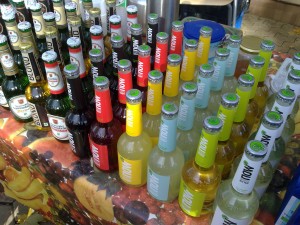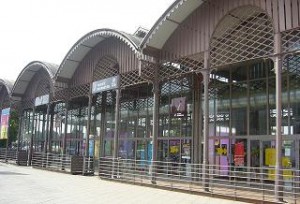 |
| Drinks at weekly organic market in the Alameda, Sevilla |
Today I'm going to talk about food, which is an obsession in Andalucia, in case you didn't know. And more specifically, food markets.
Farmer's markets and organic produce are both part of life in the UK and US, and have been for some years now. Like most things, they have taken a wee while to arrive in Spain. But Seville now boasts its own weekly organic market, in the Alameda.
You can get your fruit and veg; olive oil (one of Andalucia's principal organic products); honey; soap; tea; and wine. My personal favourite is the German bakery, Das Brot; based in Tavira, they already have a shop here in Seville, in Calle San Luis, but buying cake from a market stall on a Saturday morning has a certain ring to it which I like. They have all sorts of delicious, healthy bread, tarts and cakes, and you can find them all over Andalucia. The bread comes in brown paper bags and is quite unlike anything else you that is made here, both in terms of taste and texture: dense, and heavy, w¡th a strong flavour.
When I first arrived in Seville, over seven years ago, there were very few places selling organic products. The number has gone up since then, though not that much, so this market is a welcome new regular event. Organic production itself in Andalucia is surprisingly widespread, considering the lack of produce available to the public. This is partly because people aren't prepared to pay the prices - sometimes double - which it costs, and partly because they just don't know what it is. In the UK and US, pesticide and chemical-free food is the norm for many people. Also, some people don't trust Spanish organic certification - it may say it's organic, but what exactly does that mean? Are the regulations strict enough, and are they really adhered to?
Organic production is increasing in Andalucia: in 2009, there were nearly 8,000 producers, up 4% on the previous year, with the majority in Almeria and Granada. Although the provinces with most land given over to organic production are Huelva and Jaen, with the latter's main crop producing one of the region's main organic products: olive oil, which accounts for 31% of organic crops in Andalucia. In total, the amount of land given over to organic production in 2009 increased by over 10% - that's a considerable amount. The greater the demand for organic goods in Andalucia, the more of this healthy food will stay here for us to enjoy.
 |
| Nave de Barranco, site of future gastro-market |
And so to the other piece of gastronomic news for today: Seville is about to get its very own gourmet market, in the style of Mercado San Miguel in Madrid. The Nave de Barranco, a beautiful cast-iron-and-glass building next to the Triana bridge, designed by one of Eiffel's disciples and which used to house a tourist office and exhibition space, will be its home. A second storey will have to be built to make more space to accommodate the market.
It's a great location, just outside the centre but still easy to get to, and in the busy Plaza de Armas-Paseo Colon-Triana Bridge area, which many people pass through on foot. It's a wonderful idea, but like many cynics in the city, I wonder if it will actually happen - and within our lifetime.
Here is a short video in which you can see the interior of the Nave. Nave de Barranco, Sevilla